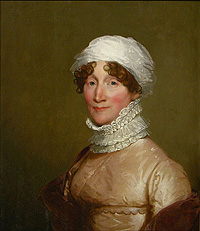Loyalists

Gilbert Charles Stuart (1755-1828), American
Elizabeth Hazen Chipman, 1817
oil on panel
65 x 54.7 cm
Gift of the estate of William C. Lee, 1991 (991.23.3)
The influx of Loyalists, beginning in 1783, after the American Revolution more than doubled the population and led to the formation of New Brunswick as a province separate from Nova Scotia.
The Revolution had a profound effect on the people of the Thirteen Colonies. It split families, ended friendships and drove those loyal to the British crown from the land that had been theirs. Many were unable to continue their professions after the war and some faced criminal charges, including treason. They left as refugees aboard ships that would take them to an unfamiliar place. Land grants were available and they were given provisions to begin their new lives, but many also managed to bring a few precious possessions with them. Some of these have passed down through their families and were ultimately donated to the Museum.
Whereas most Loyalist artefacts came in after the New Brunswick Museum was formed in 1929, a few were given to the Natural History Society in the early twentieth century.
Bibliography
Bell, D.G. Early Loyalist Saint John: The Origin of New Brunswick Politics, 1783-1786. Fredericton: New Ireland Press, 1983.
Buckner, Phillip. “Ward Chipman” Dictionary of Canadian Biography Vol. 6, 1821-1835. Toronto: University of Toronto Press, 1987. 135-144.
Dubeau, Sharon. New Brunswick Loyalists: A Bicentennial Tribute. Agincourt, Ont.: Generation Press, 1983.
Foss, Charles H. Cabinetmakers of the Eastern Seaboard: A Study of Early Canadian Furniture. Toronto: M.F. Feheley Limited, 1977.
New Brunswick Historical Society. Loyalists’ Centennial Souvenir. Saint John, N.B.: J. A. McMillan, 1887.
Wright, Ester Clark. Alexander Clark, Loyalist: A Contribution to the History of New Brunswick. Kentville, N.S.: Kent Ville Publishing Company, 1940.









